| Iris | |
|---|---|
 | |
| Blood Iris (Iris sanguinea), known as ayame in Japan | |
| Scientific classification | |
| Kingdom: | Plantae |
| Division: | Magnoliophyta |
| (unranked): | Monocots |
| Order: | Asparagales |
| Family: | Iridaceae |
| Subfamily: | Iridoideae |
| Tribe: | Irideae |
| Genus: | Iris L. |
| Type species | |
| Iris germanica L. | |
| Subgenera | |
| Hermodactyloides Iris Limniris Nepalensis Scorpiris Xiphium | |
| Synonyms | |
| Iridodictyum Juno Junopsis Xiphion | |
The genera Belamcanda (blackberry lily), Hermodactylus (snake's head iris), Neomarica (walking iris) and Pardanthopsis are sometimes included in Iris.
Contents |
Description

Rhizomes of ornamental irises
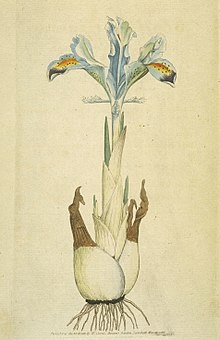
Iris persica, a bulbous iris
Irises are perennial herbs, growing from creeping rhizomes (rhizomatous irises), or, in drier climates, from bulbs (bulbous irises). They have long, erect flowering stems, which may be simple or branched, solid or hollow, and flattened or have a circular cross-section. The rhizomatous species usually have 3–10 basal, sword-shaped leaves growing in dense clumps. The bulbous species have cylindrical, basal leaves.
The inflorescences are fan-shaped and contain one or more symmetrical six-lobed flowers. These grow on a pedicel or lack a footstalk. The three sepals, which are spreading or droop downwards, are referred to as "falls". They expand from their narrow base, which in some of the rhizomatous irises has a "beard" (a tuft of short upright extensions growing in its midline), into a broader expanded portion ("limb"), often adorned with veining, lines or dots. The three, sometimes reduced, petals stand upright, partly behind the sepal bases. They are called "standards". Some smaller iris species have all six lobes pointing straight outwards, but generally, limb and standards differ markedly in appearance. They are united at their base into a floral tube that lies above the ovary (known as an inferior ovary). The styles divide towards the apex into petaloid branches; this is significant in pollination.
The iris flower is of special interest as an example of the relation between flowering plants and pollinating insects. The shape of the flower and the position of the pollen-receiving and stigmatic surfaces on the outer petals form a landing-stage for a flying insect, which in probing the perianth for nectar, will first come in contact of perianth, then with the stigmatic stamens in one whorled surface which is borne on an ovary formed of three carpels. The shelf-like transverse projection on the inner whorled underside of the stamens is beneath the over-arching style arm below the stigma, so that the insect comes in contact with its pollen-covered surface only after passing the stigma; in backing out of the flower it will come in contact only with the non-receptive lower face of the stigma. Thus, an insect bearing pollen from one flower will, in entering a second, deposit the pollen on the stigma; in backing out of a flower, the pollen which it bears will not be rubbed off on the stigma of the same flower.
The iris fruit is a capsule which opens up in three parts to reveal the numerous seeds within. In some species, these bear an aril.
Systematics and taxonomy
Up to 300 species – many of them natural hybrids – have been placed in the genus Iris. Modern classifications, starting with W. R. Dykes' 1913 book, have subdivided them. Dykes referred to the major subgroupings as sections, but later authors have generally called them subgenera, while essentially retaining his groupings. Like some older sources, the influential classification by G. I. Rodionenko removed some groups (particularly the bulbous irises) to separate genera, but even if this is done the genus remains large and several subgenera, sections and/or subsections are recognised within it.[3]In general, modern classifications usually recognise six subgenera, of which five are restricted to the Old World; the sixth (subgenus Limniris) has a Holarctic distribution. The two largest subgenera are further divided into sections.
Subgenus Iris
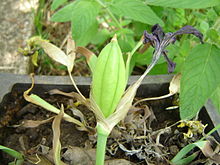
Iris reichenbachii fruit
Section Iris
|
|
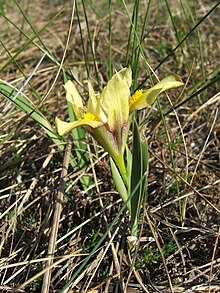
Iris humilis ssp. arenaria
Subgenus Limniris
Beardless rhizomatous irisesSection Limniris
- Iris confusa – Bamboo Iris
- Iris cristata – Crested Iris
- Iris gracilipes A.Gray
- Iris japonica Thunb.
- Iris lacustris – Dwarf Lake Iris
- Iris milesii Foster
- Iris tectorum Maxim. – Wall Iris
- Iris tenuis S.Wats. – Clackamas Iris
- Iris wattii Baker ex Hook.f.
Subgenus Xiphium
Smooth-bulbed bulbous irises. Formerly genus Xiphion.Section Xiphium
- Iris boissieri Henriq
- Iris filifolia Boiss.
- Iris juncea Poir.
- Iris latifolia – English Iris
- Iris serotina Willk. in Willk. & Lange
- Iris tingitana Boiss. & Reut. – Morocco Iris
- Iris xiphium – Spanish Iris, Dutch Iris, Small Bulbous-rooted Iris
Subgenus Nepalensis
Bulbous irises. Formerly genus Junopsis.Section Nepalensis
- Iris collettii Hook.
- Iris decora Wall.
Subgenus Scorpiris
Smooth-bulbed bulbous irises known as "junos". Formerly genus Juno.Section Scorpiris
|
|
Subgenus Hermodactyloides
Reticulate-bulbed bulbous irises. Formerly genus Iridodictyum.Section Hermodactyloides
- Iris bakeriana Foster
- Iris danfordiae (Baker) Boiss.
- Iris histrio Rchb.f.
- Iris histrioides (G.F.Wilson) S.Arn.
- Iris kolpakowskiana Regel
- Iris pamphylica Hedge
- Iris reticulata Bieb.
- Iris vartanii Fost.
- Iris winogradowii Fomin
Uses
In horticulture
Irises are extensively grown as ornamental plants in home and botanical gardens. Presby Memorial Iris Gardens in New Jersey, for example, is a living iris museum with over 10,000 plants, while in Europe the most famous iris garden is arguably the Giardino dell'Iris in Florence (Italy) which every year hosts one of the most famous iris breeders' competitions in the world.The most commonly found garden iris is the bearded German Iris (I. germanica), a hybridogenic species, and its numerous cultivars. Various wild forms and naturally occurring hybrids of the Sweet Iris (I. pallida) and the Hungarian Iris (I. variegata) form the basis of most all modern hybrid bearded irises. Median forms of bearded iris (intermediate bearded, or IB; miniature tall bearded, or MTB; etc.) are derived from crosses between tall and dwarf varieties.
The bearded irises are easy to cultivate and propagate, and have become very popular in gardens. They grow in any good free garden soil, the smaller and more delicate species needing only the aid of turf ingredients, either peat or loam, to keep it light and open in texture. The earliest to bloom are species like I. junonia and I. reichenbachii, which flower as early as February and March, followed by the dwarf forms of I. pumila which blossom during March, April and May. During the latter month and the following one, most of the larger-growing "tall bearded" irises bloom, such as the German Iris and its variety florentina, Sweet Iris, Hungarian Iris, Lemon-yellow Iris (I. flavescens), Iris sambucina, I. amoena, and their natural and horticultural hybrids such as those described under names like I. neglecta or I. squalens and best united unter I. × lurida.
The section Oncocyclus contains the cushion irises or royal irises, a group of plants noted for their large, strongly marked flowers. Between 30 and 60 species are classified in this section, depending on the authority. Compared with other irises the cushion varieties are scantily furnished with narrow sickle-shaped leaves and the flowers are usually borne singly on the stalks; they are often very dark and in some almost blackish. The cushion irises are somewhat fastidious growers, and to be successful with them they must be planted rather shallow in very gritty well-drained soil. They should not be disturbed in the autumn, and after the leaves have withered the roots should be protected from heavy rains until growth starts again naturally.
The section Regelia, closely allied to the cushion irises, includes several garden hybrids with species in section Oncocyclus, known as Regelio-cyclus irises. They are best planted in September or October in warm sunny positions, the rhizomes being lifted the following July after the leaves have withered.
A truly red bearded iris remains an unattained goal despite frequent hybridizing and selection. There are species and selections, most notably based on the beardless rhizomatous Copper Iris (I. fulva), which have a relatively pure red color. However, getting this color into a modern bearded iris breed has proven very difficult, and thus, the vast majority of irises are in the purple and blue range of the color spectrum, with yellow and whitish breeds also quite frequent.
Other beardless rhizomatous iris types commonly found in garden are the Siberian Iris (I. sibirica) and its hybrids, and the Japanese Iris (I. ensata) and its hybrids. "Japanese Iris" is also a catch-all term for the Japanese Iris proper (hanashōbu), the Blood Iris (I. sanguinea, ayame) and the Rabbitear Iris (I. laevigata, kakitsubata). I. unguicularis is a late-winter-flowering species from Algeria, with sky-blue flowers blotched with yellow, produced (in the Northern Hemisphere) from November to March or April. Yet another beardless rhizomatous iris popular in gardening is I. ruthenica, which has much the same requirements and characteristics as the "tall bearded" irises.
Many of the smaller species of bulbous iris, being liable to perish from excess of moisture, should have a well-drained bed of good but porous soil made up for them, in some sunny spot, and in winter should be protected by a covering of half-decayed leaves or fresh cocos-fibre refuse. To this group belong the "reticulate" irises with their characteristic bulbs, including I. danfordiae, I. histrioides, I. reticulata and others, as well as the smmoth-bulbed I. filifolia, which flower as early as February and March
| Iris atropurpurea, one of the dark-flowered Oncocyclus bearded irises | |||
| Iris unguicularis flower | Iris pseudacorus in Cheshire in England |
Aromatic rhizomes
Rhizomes of the German Iris (I. germanica) and Sweet Iris (I. pallida) are traded as orris root and are used in perfume and medicine, though more common in ancient times than today. Today Iris essential oil (absolute) from flowers are sometimes used in aromatherapy as sedative medicines. The dried rhizomes are also given whole to babies to help in teething. Gin brands such as Bombay Sapphire and Magellan Gin use orris root and sometimes iris flowers for flavor and color.For orris root production, iris rhizomes are harvested, dried, and aged for up to 5 years. In this time, the fats and oils inside the roots undergo degradation and oxidation, which produces many fragrant compounds that are valuable in perfumery. The scent is said to be similar to violets. The aged rhizomes are steam-distilled which produces a thick oily compound, known in the perfume industry as "iris butter".
Iris rhizomes also contain notable amounts of terpenes, and organic acids such as ascorbic acid, myristic acid, tridecylenic acid and undecylenic acid. Iris rhizomes can be toxic. Larger Blue Flag (I. versicolor) and other species often grown in gardens and widely hybridized contain elevated amounts of the toxic glycoside iridin. These rhizomes can cause nausea, vomiting, diarrhea, and/or skin irritation, but poisonings are not normally fatal. Irises should only be used medicinally under professional guidance.
In water purification
Further information: Organisms_used_in_water_purification
Further information: Treatment_pond
In water purification, Yellow Iris (I. pseudacorus) is used. The roots are usually planted in a substrate (e.g. lava-stone) in a reedbed-setup. The roots then improve water quality by consuming nutrient pollutants, such as from agricultural runoff.In art and symbolism
The Purple Iris is the State Flower of Tennessee.The artist George Gessert has specialised in breeding irises.[4]
The artist Vincent van Gogh painted several famous pictures of irises.[5]
The American artist, Joseph Mason — a great friend of John James Audubon — painted a precise image of what was then known as the Lousianna Flag or Copper Iris (Iris cuprea) to which Audubon subsequently added two Northern Paraula birds (parula americana) for inclusion as Plate 15 in his Birds of America.
The artist Philip Hermogenes Calderon painted an iris in his 1856 work Broken Vows; he followed the principles of the Pre-Raphaelite Brotherhood. An ancient belief is that the iris serves as a warning to be heeded, as it was named for the messenger of Olympus. It also conveys images of lost love and silent grief, for young girls were led into the afterlife by Iris. Broken Vows was accompanied with poetry by Henry Wadsworth Longfellow when it was first exhibited.[6]
The fleur-de-lis, a stylized iris, first occurs in its modern use as the emblem of the House of Capet. The fleur-de-lis has been associated with France as Louis VII adopted it as a symbol in the 12th Century. The yellow fleur-de-lis reflects the Yellow Iris (I. pseudacorus), common in Western Europe. Contemporary uses can be seen in the Quebec flag and the logo of the New Orleans Saints professional football team, and on the flag of Saint Louis, Missouri.
The red fleur-de-lis in the coat-of-arms of Florence (Italy) descends from the white iris which is native to Florence and which grew even in its city walls. This white iris, displayed against a red background, became the symbol of Florence until the Medici family, to signal a change in political power, reversed the colors making the white one red and setting in motion a centuries-long breeding program to hybridize a red iris.
Furthermore, the fleur-de-lis is the almost-universal symbol of Scouting and one of the symbols adopted by the sorority, Kappa Kappa Gamma.
A stylized Yellow Iris is the symbol of Brussels, since historically, the important Saint Gaugericus Island was carpeted in them.[7] The iris symbol is now the sole feature on the flag of the Brussels-Capital Region.
An iris – species unspecified – is one of the state flowers of Tennessee. Tradition holds that the particular iris symbolizing Tennessee is a purple cultivar, to go alongside the wild-growing Purple Passion Flower (Passiflora incarnata) which is the state's other floral emblem.
The provincial flower of Québec (Canada) is the Harlequin Blueflag (I. versicolor), called iris versicolore in French.
| Philip Hermogenes Calderon's Broken Vows with the iris at lower left | Coat-of-arms of the House of Capet | ||
| Coat of Arms of Ukraine is a stylized iris[verification needed], a symbol of the Perun (thunder god) from the pagan antiquity. |

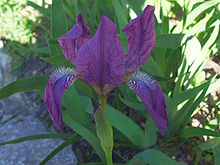



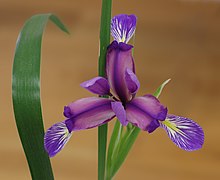






















No comments:
Post a Comment